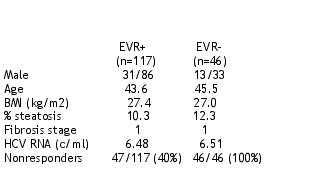| |
Fat in the Liver Reduces Response to HCV Therapy
Reported by Jules Levin
|
| |
| |
Steatosis, also called fatty liver, is the accumulation of fat in hepatocytes (liver cells in the liver). This is a common finding. As specific causes of liver disease have been identified and characterized, more attention has focused on the causes and consequences of fatty liver, also called more scientifically as hepatic steatosis.
Although alcoholism can lead to fatty liver, you don't have to be an alcoholic to develop fatty liver. Non-alcoholic steatosis is called NASH. How these syndromes develop are not well understood. Alcohol-related fatty liver is distinguished from non-alcoholic fatty liver. Following is a brief discussion of NASH.
It is well known that HIV-infected individuals have abnormal metabolic and lipid profiles. Cholesterol, triglycerides, diabetes, and insulin resistance can be problems associated with HAART. Researchers have not yet started to address the potential affect of HIV-associated metabolic abnormalities on the liver and liver disease progression, particularly in patients coinfected with hepatitis B and C.
Although the factors that cause fatty liver are not presently known, it is believed that metabolic abnormalities and nutritional deficits may play roles in contributing to fatty liver.
Fatty liver is found in 21% of lean healthy males, while almost all morbidly obese individuals will have fatty liver. In the less obese, including those with body mass higher than 10% above lean body weight, about 75% have some degree of fatty liver. How fat is distributed on the body predicts the presence of fatty liver. A high ratio of abdominal fat to hip fat is a significant risk factor for fatty liver. Fatty liver is found in obese children just as frequently as adults.
One study at DDW found increased body mass index can be associated with more fibrosis, advanced liver disease, and can also be associated with reduced tolerability of HCV therapy (interferon/ribavirin). The study I'll discuss now found that fatty liver which is associated with obesity, accumulation of abdominal fat, and diabetes may reduce the response rate to HCV therapy.
At DDW Keyur Patel (Duke University) reported results from: "Steatosis Influences the Early Virologic Response Rate in Patients with Chronic Hepatitis C Infection".
The early virologic response rate foe patients receiving peginterferon plus ribavirin is about 80%. That is, 80% of patients achieve undetectable HCV viral load or a 2-log reduction by week 12 of therapy. It is known that low weight and BMI are predictive of favorable response. Additional predictors of better response are genotype 2/3, absence of fibrosis, low viral load, females gender, and younger age. An earlier study (Hepatology 2002;36(4):281A) found that SVR nonresponders with genotype 1 were significantly more likely to have fatty liver (10% vs 4.6% for viral responders). There was a trend towards genotype 1 SVR nonresponder patients to have fatty liver more often (16.4% vs 14.3% for viral responders).
The study presented at DDW was a retrospective analysis of 574 treatment-naive chronic HCV patients from a single center with biopsies available. Interferon-based therapy was provided with combination interferon or peginterferon plus ribavirin. Liver biopsies evaluated for steatosis by two investigators (k=0.84, p<0.005). Percent hepatocytes with macrovescular staetosis determined for >5 high power fields. A categorical grade of steatosis was assigned:
--grade 0 (0-2%)
--grade 1 (3-29%)
--grade 2 (30-59%)
--grade 3 (>60%)
Hepatic fibrosis was assessed according to the METAVIR scoring system.
The effects of host/viral factors were assessed using stepwise logistic regression analysis with EVR as the outcome parameter. Baseline factors evaluated in the multivariate model include:
Age
Gender
Alcohol intake
BMI
Steatosis (grade and %)
Fibrosis stage
Genotype
Treatment type
PATIENT CHARACTERISTICS
Patients who were EVR+ (were HCV RNA negative) and patients who were EVR- (patients who did not have early viral response).
|
|
 |
| |
RESULTS
Genotype 1 patients with EVR were more likely to have grade 0 steatosis compared to patients that did not achieve EVR (71% vs 42%, p=0.003). By my view of the chart presented on slide, patients without an EVR appeared to be more likely to have more advanced grades of steatosis.
Patients with genotype 1 (n=106) not achieving an EVR were significantly more likely to have steatosis, 12.7% while only 4.4% of patients who did not achieve EVR had steatosis. However, there was no affect found in non-1 genotype patients on EVR by steatosis: 18.3% of non-genotype 1 patients with EVR had steatosis compared to 11.4% of patients who did not achieve EVR (p=n.s.). The authors found that as the percent of patients with steatosis increased the predicted odds of EVR decreased.
MULTIVARIATE ANALYSIS
--regression model based on steatosis being linear to 25%
--when factored into a multivariate model, genotype 1 (p=0.007) and percent steatosis (p=0.046) remained significant predictors of EVR.
The authors concluded:
--these results are preliminary
--valid for steatosis linearity to 25%
--steatosis is an independent variable that reduces EVR in chronic hepatitis C infection
--these findings require further validation in larger studies
The authors recommended:
--steatosis should be evaluated in future prospective studies as a potential variable affecting treatment outcome
--studies should examine the effect of lifestyle modification and weight loss on steatosis and virologic and histologic outcomes
|
|
| |
| |
|
|
|